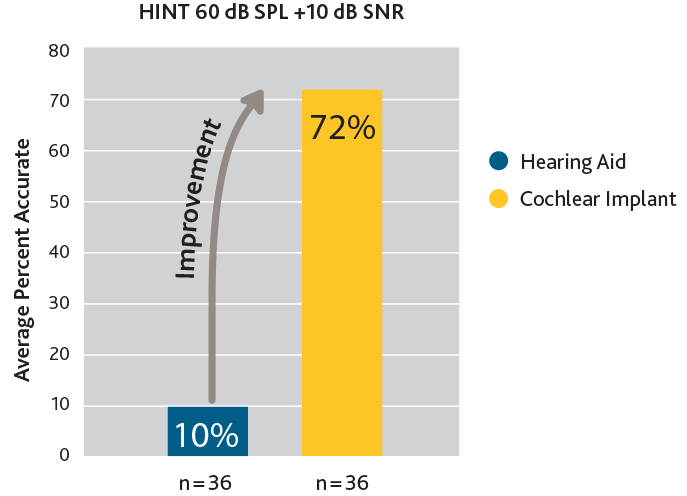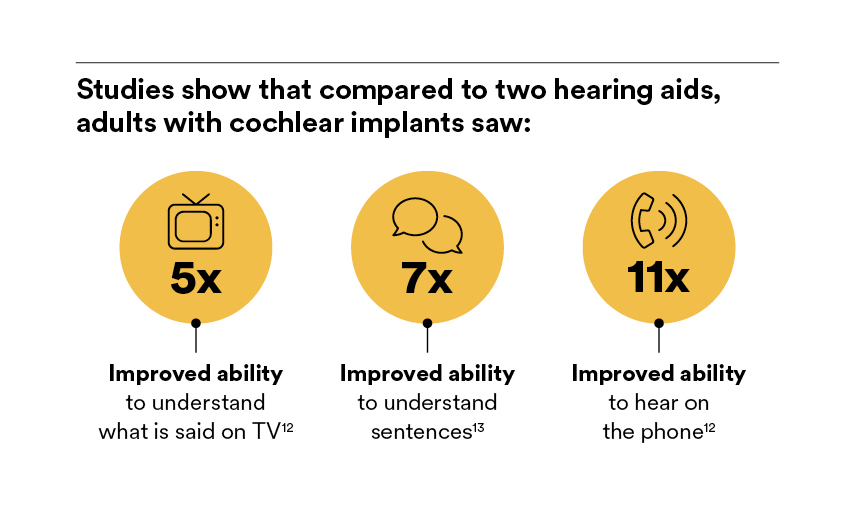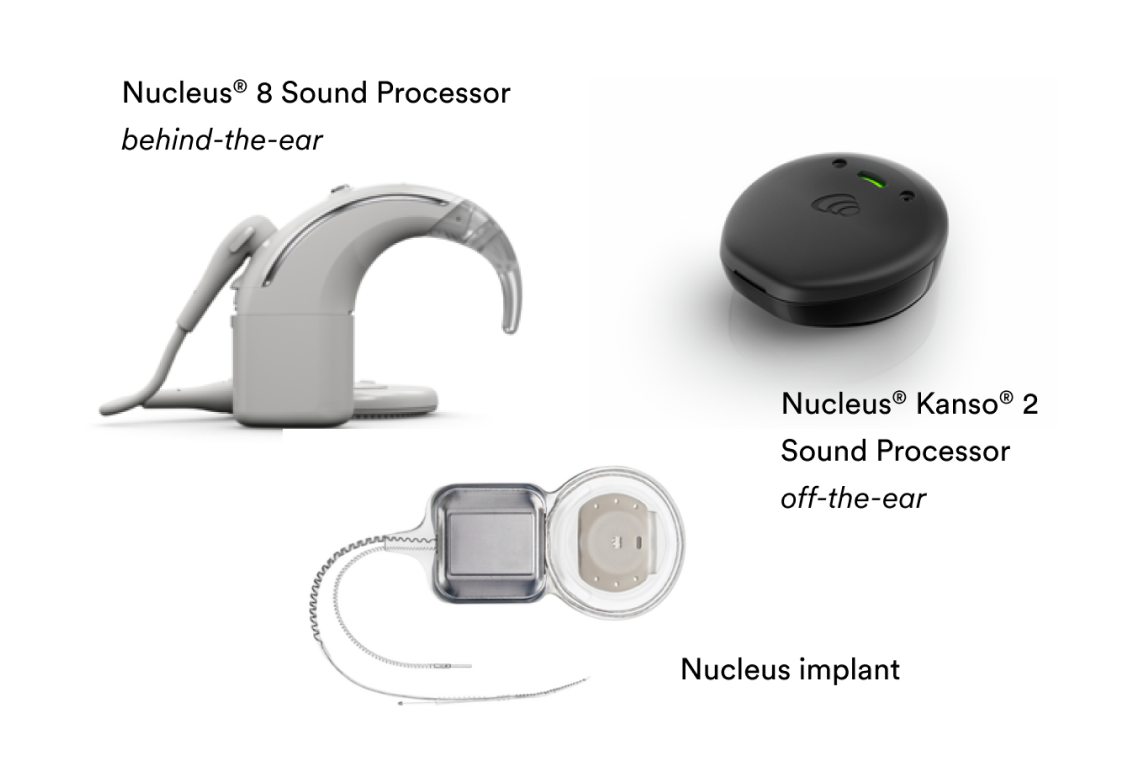Cochlear implants may be a solution if your hearing aids
are not helping you
understand sounds and speech.
Staying connected with one another has never been more important. Whether you prefer a sound processor that sits off-the-ear or behind-the-ear, you can experience the comfort of the world’s smallest sound processors.1 With the latest technology that is designed to help you hear clearly, you can feel empowered to connect with your world and do more of what you love.2-5
Do you qualify for a cochlear implant?
Cochlear implants work differently than hearing aids. Hearing aids help many people with hearing loss by making sounds louder. However, cochlear implants can be a more effective option for those with more significant hearing loss; specifically moderate to profound hearing loss in adults. For some people, using a hearing aid(s) with a severe to profound hearing loss can be like listening to a loud, badly tuned radio.You may hear parts of what is being said and it may be loud enough, but the words are not clear.
Note: Wearing hearing aids first is a necessary step in the evaluation process for a cochlear implant.
Want to know if a cochlear implant may be a solution for you?
Take a Short Quiz!How much does a cochlear implant cost?
Unlike hearing aids, cochlear hearing implants may be covered by Medicare.† They are also covered by many insurance plans and typically Medicaid.* Contact your insurance company or local Hearing Implant Specialist to determine coverage as well as your estimated out-of-pocket expenses. The cost of a cochlear implant will vary from person to person based on their specific health plan.
| Private Insurance | Medicaid | Medicare | |
|---|---|---|---|
| Cochlear implant systems | Covered by most insurance plans* | Typically covered** | Typically covered† |
| Hearing aids | Generally not covered1 | Typically covered** | By law are not covered in traditional Medicare. Coverage may be available in certain Medicare Advantage Plans. |
For candidates residing in Canada, you should contact your local hearing implant center to determine coverage. The cost of a hearing implant may be covered by your provincial and territory health insurance plan. Every health insurance plan is different. Coverage varies by each province and territory, the type of hearing implant you may need and your hearing loss.
* Contact your insurance company or local Hearing Implant Specialist to determine your eligibility for coverage.
** Coverage for adult Medicaid recipients varies according to state-specific guidelines.
† Covered for Medicare beneficiaries who meet CMS criteria for coverage.
1. Coverage of hearing aids may be an option under some plans.
Lifestyle and Health Benefits of Cochlear Implants
Hearing your friends and family in noisy situations is especially difficult for those with hearing loss. You do not need to wait until you lose all your hearing to benefit from a cochlear implant. You can hear better, sooner and experience health benefits with improved hearing outcomes.
In fact, adult cochlear implant users demonstrated a significant improvement in hearing in noise when compared to their hearing aid performance.6
Research and decades of experience demonstrate cochlear implants help improve:
- Speech understanding, sound clarity and language skills7
- Hearing in noise8
- Quality of life8
- Employment opportunities9
- Experience less fatigue after long periods of listening10
- Experience better sound localization11
Better Hearing in Noise with a cochlear implant6

*The Hearing in Noise Test (HINT) measures a person’s ability to hear speech in quiet and at a normal conversational level.

It is important that you have realistic expectations of the benefits of a cochlear implant. It will take commitment, patience and support.
The first step to better hearing is to have your hearing checked by a Hearing Implant Specialist.
How the Cochlear™ Nucleus® Implant System Works
There are two primary components of the Cochlear™ Nucleus® System: the external sound processor and the implant that is surgically placed underneath the skin attached to the electrode array that is inserted in the cochlea.
We offer a choice of sound processor wearing options.

Watch the video to see how the Cochlear™ Nucleus® System works.
Smaller, smarter, better connected.29
Nucleus® 8 Sound Processor
Our small
and smart behind-the-ear sound processor
Kanso® 2 Sound Processor
The smallest
and lightest off-the-ear sound processor
Cochlear™ Nucleus® 8 Sound Processor
Nucleus® 8 Sound Processor
Engage with the moments that matter and experience the comfort of the world’s smallest and lightest behind-the-ear cochlear implant sound processor.1 Designed to make communicating with people easier, the Nucleus® 8 Sound Processor delivers our latest hearing technology which automatically adjusts to your listening environment.2-5 Ready for next-generation Bluetooth® LE Audio technology*, it will make it easy to bring sound to you – in more places and from more devices than ever before.4,14-15
Smaller, smarter and better connected, the Nucleus® 8 Sound Processor opens up a world of possibilities1,5,16-17 with our latest in innovation featuring:
- Sound processing technology enhancements with SCAN 2 and SmartSound® iQ2
- Next-generation Bluetooth® LE Audio technology
- Improved ForwardFocus
*When the technology becomes available for the Cochlear Nucleus 8 Sound Processor, a firmware update to your sound processor will allow you to connect to Bluetooth LE Audio compatible devices.
Personalizing your Nucleus Sound Processor
The Nucleus 8 Sound Processor comes in a range of six color options
to best suit your style:
Black, Brown, Sand, Silver, Grey and
White.
Nucleus® Kanso® 2 Sound Processor

The Nucleus Kanso® 2 Sound Processor
The Kanso® 2 Sound Processor is the smallest and lightest rechargeable off-the-ear solution18 available that has built-in technology offering direct streaming, control and connectivity with a compatible Apple or Android device.* It is designed for simplicity with an auto on/off feature, or you can just tap the sound processor to turn it on and off; no buttons to push.
The Kanso 2 Sound Processor features an innovative, built-in rechargeable battery that provides the convenience of helping you hear your best all day and on the go, while delivering proven hearing performance.19
The Kanso Sound 2 Processor features our most advanced technologies, including:
- Direct streaming form a compatible smartphone
- Easily control and monitor your hearing experience from the Nucleus Smart App
- Automatic sound processing technology with SmartSound® IQ® with SCAN
- True Wireless™ Connectivity
- Dual microphones to help you hear your best, especially in noisy environment.
*SNR-NR and WNR are approved for use with any recipient ages 6 years and older, who is able to 1) complete objective speech perception testing in quiet and in noise in order to determine and document performance 2) report a preference for different program settings.
The Cochlear Kanso 2 Sound Processor is compatible with Apple and Android devices. For compatibility information visit www.cochlear.com/compatibility.
A range of color options to match your hair or stand out
Choose the color of your Kanso 2 Sound Processor to suit your style.

Learn More About The Nucleus® 8 Sound Processor
Cochlear™ Nucleus® 7 Sound Processor
Nucleus® 8 Sound Processor
Engage with the moments that matter and experience the comfort of the world’s smallest and lightest behind-the-ear cochlear implant sound processor.1 Designed to make communicating with people easier, the Nucleus® 8 Sound Processor delivers our latest hearing technology which automatically adjusts to your listening environment.2-5 Ready for next-generation Bluetooth® LE Audio technology*, it will make it easy to bring sound to you – in more places and from more devices than ever before.4,14-15
Smaller, smarter and better connected, the Nucleus® 8 Sound Processor opens up a world of possibilities1,5,16-17 with our latest in innovation featuring:
- Sound processing technology enhancements with SCAN 2 and SmartSound® iQ2
- Next-generation Bluetooth® LE Audio technology
- Improved ForwardFocus
*When the technology becomes available for the Cochlear Nucleus 8 Sound Processor, a firmware update to your sound processor will allow you to connect to Bluetooth LE Audio compatible devices.
Personalizing your Nucleus Sound Processor
The Nucleus 8 Sound Processor comes in a range of six color options
to best suit your style:
Black, Brown, Sand, Silver, Grey and
White.
Learn More About The Kanso® 2 Sound Processor
Nucleus® Kanso® Sound Processor
The Nucleus Kanso® 2 Sound Processor
The Kanso® 2 Sound Processor is the smallest and lightest rechargeable off-the-ear solution18 available that has built-in technology offering direct streaming, control and connectivity with a compatible Apple or Android device.* It is designed for simplicity with an auto on/off feature, or you can just tap the sound processor to turn it on and off; no buttons to push.
The Kanso 2 Sound Processor features an innovative, built-in rechargeable battery that provides the convenience of helping you hear your best all day and on the go, while delivering proven hearing performance.19
The Kanso Sound 2 Processor features our most advanced technologies, including:
- Direct streaming form a compatible smartphone
- Easily control and monitor your hearing experience from the Nucleus Smart App
- Automatic sound processing technology with SmartSound® IQ® with SCAN
- True Wireless™ Connectivity
- Dual microphones to help you hear your best, especially in noisy environment.
*SNR-NR and WNR are approved for use with any recipient ages 6 years and older, who is able to 1) complete objective speech perception testing in quiet and in noise in order to determine and document performance 2) report a preference for different program settings.
The Cochlear Kanso 2 Sound Processor is compatible with Apple and Android devices. For compatibility information visit www.cochlear.com/compatibility.
A range of color options to match your hair or stand out
Choose the color of your Kanso 2 Sound Processor to suit your style.

See how cochlear implants have changed the lives of others.
Watch these videos to see first-hand how cochlear implants have changed lives and may be able to change yours.
Benefits of bimodal hearing
The natural combination
Discover more natural hearing20, improved speech understanding21-23 and perception of music24 when you combine the benefits of a hearing aid in one ear and a cochlear implant in the other. Your ears work as a team, so using both ears can help the brain to process and understand sounds better than using just one ear.24
Cochlear™ Sound Processors can be worn with any hearing aid, so no matter what hearing aid you’re using, you’ll get the benefits of hearing with both ears. Delivering a better hearing experience, a bimodal solution can help you locate where sound is coming from, enhance your music appreciation, and enjoy an improved quality of life than with hearing aids alone.26-28
Your journey to better hearing is worth every step.
Learn more about the steps to getting a cochlear implant.
Step 1: Hearing Test
You will need to have your hearing tested by a Hearing Implant Specialist to determine if you are a candidate for a cochlear implant.
Step 2: Insurance Approval
Your Hearing Implant Specialist will work with your insurance company to determine your eligibility for coverage.
Step 3: Surgery
Cochlear implant surgery is a fairly routine outpatient procedure that usually takes between two to four hours under general anesthesia.
Step 4: Activation
Two to four weeks after surgery, you will have an appointment with your audiologist to activate your cochlear implant. This is the day you will begin to hear sound through your cochlear implant for the first time. How well you will hear right away will vary from person to person depending on length and degree of hearing loss.
Step 5: Ongoing Rehabilitation & Care
Just as with any surgical procedure, you will need to undergo rehabilitation. Your brain will need to be retrained to understand sounds. You will have a series of appointments over the first several months so your audiologist can make adjustments and fine tune your sound processor to help ensure your best hearing experience. Of course, you will have to continue to practice at home as well utilizing rehabilitation tools that can be tailored to your hearing needs.



